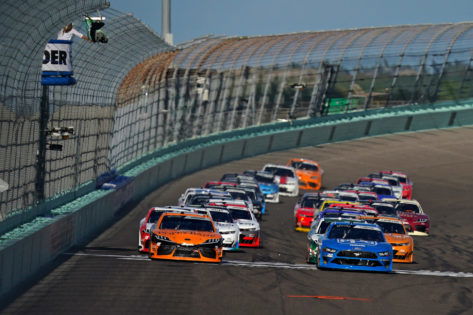In NASCAR’s storied history, veteran drivers occasionally develop an almost supernatural ability to foresee the sport’s evolution. Weeks before chaos erupted at Martinsville’s paper-clip turns, one such driver quietly offered an assessment that would later seem eerily prophetic.
The conversation, captured during a media session with journalist Matt Weaver and shared by Steven Taranto, initially meandered through discussions of technological evolution and competitive balance. What made this exchange remarkable wasn’t immediately apparent to those present—but as events unfolded at Martinsville Speedway during last Saturday’s Xfinity Series race. The driver’s casual observation transformed from simple opinion into a bold prediction, and that eventually came true after Austin Hill won the Xfinity Series race at the short track in Virginia.
It was Ryan Preece who delivered the uncanny prediction, offering a blunt assessment that cut to the heart of modern short-track competition: “I don’t even think the Xfinity Series racing at Martinsville is that great. I just see guys knocking each other out of the way. That’s it.” His words would prove remarkably prescient as the recent Martinsville event devolved into precisely the bumper-car spectacle he had described, with multiple last-lap incidents ultimately deciding the outcome.
Preece didn’t stop at mere observation, adding a sharp critique that distinguished between aggression and skill: “I don’t think that’s racing. I can go to a local go-kart track and knock a guy out of the way and do the same damn thing.” His comparison to go-kart tactics emphasizes his belief that true racing involves more than contact-based passing strategies. Preece further highlighted the contrast with the Next Gen car, noting, “if you smash a guy, you’re not going to jack. You can’t stick your nose under the guy like you can in those cars.” Little did we know that Preece’s mere mention of the current state of short-track racing would blow into a controversy.
Thought Ryan Preece said some pretty smart and informed things about the Next Gen car on short tracks yesterday and how he thinks it’s only going to get better
– Mentioned how it’s helped the outside line be more of a factor
– Likes what Goodyear is doing with the tire, doesn’t… pic.twitter.com/vZ8aCVLdNZ
— Steven Taranto (@STaranto92) March 27, 2025
The Xfinity Series race at Martinsville on March 29 vindicated Preece’s assessment with striking accuracy. Through a series of restarts and a red flag, the race deteriorated into what was described as a “crash fest.” With only a few laps remaining, Sammy Smith moved Taylor Gray out of the way to take the lead, only for Gray to return the favor on the final restart. As Gray took the white flag in first position and appeared set to secure his first career Xfinity win, Smith made exactly the type of move Preece had predicted. Driving shockingly deep into the final corner from several car lengths back, Smith slammed into the back of Gray’s car, spinning him out. The resulting chaos saw Austin Hill surge from fifth to first on the final corner as the leaders wrecked. Gray finished a disappointing 29th, with Smith crossing the line in 10th. The incident was so heated that security had to keep the two drivers separated outside the infield care center to prevent a physical confrontation.
Smith’s post-race comments perfectly encapsulated the mentality Preece had criticized: “I mean, absolutely it was egregious,” Smith admitted regarding his move. “I’m not proud of that but roles reversed, he would have done the same thing.” He further justified his actions by stating, “If you’re not the one doing it, someone is going to do it to you… at the end of the day, it’s what you got to do.” For Gray, this marked his second consecutive Martinsville disappointment after being shoved from the lead during a pivotal 2024 Truck Series playoff race. “It’s the same story I’ve lived here for two Martinsville in a row,” Gray lamented.
Well, NASCAR can only do so much to police the situation. Although the current trend of short-track racing is a bit worrisome, Preece believes technology and innovation can solve the persisting issues.
The Evolution of NASCAR Technology Beyond the Predicted Limits
“In the early 2000s when we had ride-height rules and guys started to figure out coil binding on how to put the car on the ground and have an aero advantage once you got on the racetrack, like, those are all things that we thought weren’t possible until we figure out that they are,” Preece noted, referencing a significant era of NASCAR innovation. During this period, teams discovered that deliberately binding suspension components could create aerodynamic advantages that fundamentally changed the sport’s competitive landscape.
This historical perspective provides valuable context to current discussions about Goodyear’s tire development and its impact on racing quality. As Preece eloquently summarized, “That’s the thing about racing. It’s constant innovation and progression and figuring out things that you didn’t think were possible.” While Preece has a point, we need to understand that teams working at the race shops do not have a lot of wiggle room. Thanks to parity racing and Next Gen cars, the field is bunching up together, which makes it tough for teams to find that competitive advantage on the racetrack.
We’ve seen this lead the drivers to then resort to desperate moves to ensure a win. We saw that last year with Austin Hill at Richmond and Sammy Smith last weekend at Martinsville. Until and unless the current trends improve, NASCAR will need to step in and draw a clear line on what is hard racing and what is wrecking your rivals. Of course, there needs to be a rule book or a structure in place to penalize those who can’t keep themselves in check.
The post NASCAR’s Nostradamus Warns Rookies of Looming Chaos as Uncanny Martinsville Prediction Comes True appeared first on EssentiallySports.
